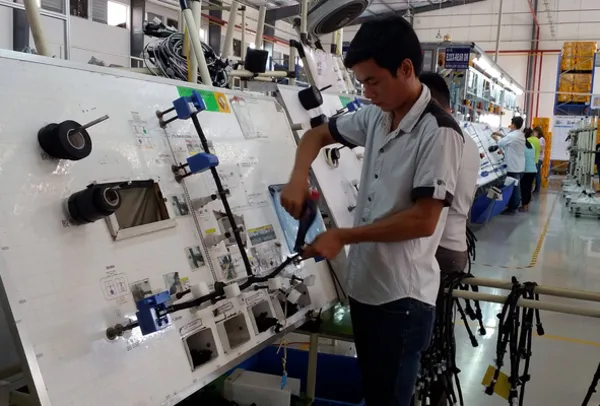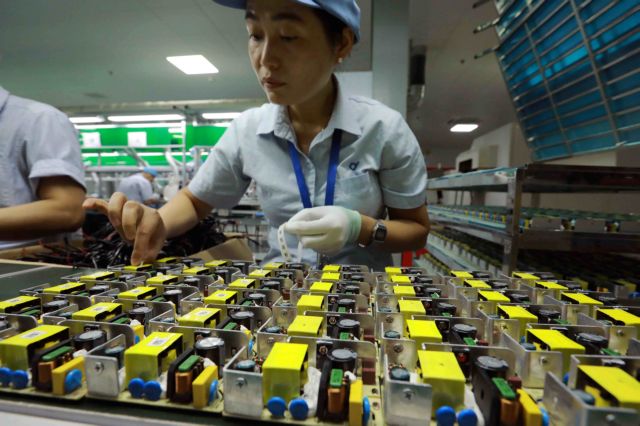 Economy
Economy

 |
| An assembly line at a Taiwanese-invested company in Hải Phòng, specialising in plastic products and electronic components for the printing industry. FDI enterprises have more advantages than domestic ones in joining the global electronics supply chains. VNA/VNS Photo |
Việt Nam's supporting industry for electronics needs more support policies from the State in addition to the efforts of enterprises to thrive.
The Government has identified electronics as a key sector in the economy, which also has a big impact on other industries.
The goal is that, by 2030 Việt Nam will become a major producer of electronics with new, smart and environmentally friendly technology.
Economic experts said that Việt Nam could be an Asian manufacturing centre of supporting products for the electronics industry.
The electronics industry has shown strong and increasing export turnover. The General Statistics Office said the electronics industry is still the lead in the manufacturing and processing industries, with high export value.
The total export turnover of the electronics industry was US$109 billion in 2023. In the first nine months of this year it climbed to $97 billion, up 10 per cent over the same period last year. This year's revenues are forecast to increase to $120 billion.
Phạm Tuấn Anh, deputy director of the Department of Industry, under the Ministry of Industry and Trade (MIT), said that Việt Nam's electronics industry had developed robustly in recent years due to attracting large investments from multinational corporations from major economies such as South Korea and Japan.
Multiple large electronics companies in the world had invested in building high-tech electronic product manufacturing facilities in Việt Nam, such as Samsung, LG, Foxconn and Fukang Technology.
Computer products and electronic components were increasingly diversifying according to domestic and export market demand. At the same time, the export structure of electronic products had changed with a higher proportion of complete and semi-finished products.
According to MIT, Việt Nam exports computers and electronic components to more than 100 markets around the world, mainly to China, ASEAN, Japan and South Korea. Electronics export nowadays is also expanding to EU markets, including the Netherlands, Germany, Czechia, Poland, and Finland.
With deep integration into the global economy, Việt Nam is becoming a key destination for many companies manufacturing electrical and electronic products in the world. Export turnover of cell phones and components is expected to reach record high in the coming years.
There are many opportunities to participate in the global supply chain, according to economic experts, but domestic enterprises are limited in numerous aspects such as capital, experience, technology, and relationships with global corporations.
The electronics industry is also facing many difficulties and challenges such as shortage of capital and human resources, especially management and production operations personnel. The industry is subject to increasingly tightened regulations on sustainable production in Europe and the US.
To have sustainable development for the electronics export business in the context of Việt Nam participating in a series of free trade agreements, supportive solutions from the State are needed.
The State should pay attention to incentives for domestic businesses in the stages of research, trial production and trade promotion programmes.
It also needs to review and improve legal policies, especially specific regulations on goods with Vietnamese origin and implement solutions to expand domestic and export markets.
According to Đỗ Thị Thúy Hương, member of the Executive Committee of the Việt Nam Electronics Enterprises Association, and vice president of the Supporting Industry Association, the current support policy for the electronics industry is the Government's Decree 111 issued on November 3, 2015. This decree has since then contributed to promoting the rapid development of supporting industries, but it still has many limitations.
Therefore, it is necessary to complete the amendment and supplementation of Decree 111 to remove bottlenecks in the market and increase credit for supporting industry enterprises.
In addition, the Ministry of Industry and Trade is drafting a law on key industries, in which the supporting industries are one of the important parts of the development strategy in the future.
A representative of the MIT Department of Industry said that building a long-term supportive strategy was needed to help improve the industry's competitiveness and manufacture high value-added products.
First, it was necessary to promote the production of screens, semiconductors and other electronic components. Production of those long-life products would require large investments over a term of 10-20 years. This investment also needed to be regular to improve production capacity and technology, creating high value-added products.
Lại Hoàng Dương, chairman of the Thánh Gióng Communications and Computer JSC, said that to take a major part in the electronics market, Việt Nam’s enterprises must prepare resources and define specific goals for a specific period.
The domestic companies also needed a lot of support from the State through programmes and activities that can access the semiconductor chip manufacturing technology and the electronics industry in general, Dương said.
The capacity of domestic enterprises in the industry is still limited and product quality and design have not met the high demands of the market. The connection between domestic suppliers with FDI enterprises and multinational corporations is still weak.
Meanwhile, previously famous electronics enterprises of Việt Nam are developing slowly or gradually losing their brands and occupying smaller market shares. Some emerging electronics brands in the domestic market are dominated by foreign firms.
The current localisation rate of the electronics industry is only about 5-10 per cent. Most electronic products in Việt Nam's market are completely imported or assembled locally from primarily imported components.
Domestic supporting industry enterprises for the electronics industry have participated in the value chain of the industry; however, most of them only provide simple products, with low technology and value.
Although there are many opportunities to participate in the global supply chains of electronic products, economic experts say Vietnamese companies, being limited in terms of capital and relationships with global corporations, also need to meet the requirements on delivery times and high technology to participate in the supply chain of large corporations. VNS




